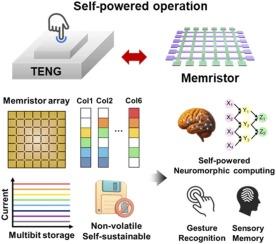具有压力驱动多电平开关和模式编码的全自供电记忆电阻交叉棒阵列
IF 17.1
1区 材料科学
Q1 CHEMISTRY, PHYSICAL
引用次数: 0
摘要
对节能数据处理的需求正在推动下一代电子设备自供电系统的发展。其中,在没有外部电源的情况下工作的忆阻器特别有希望用于神经形态和边缘计算应用,因为它们的电阻状态可以通过机械收集的能量来控制。本研究展示了一种完全自供电的忆阻器系统,该系统集成了高灵敏度摩擦电纳米发电机(TENG)和氮掺杂陶氏自整流忆阻器交叉棒阵列。该忆阻器具有接口型电阻开关,具有高整流比(> 105),超过104个周期的稳定耐用性,可靠的3位多电平数据存储。TENG将机械刺激转换成电信号,并产生足够的电压和电流,使忆阻器在没有任何外部电源的情况下工作。外部电路的优化允许高度可重复性,压力控制的多电平电阻开关。6 × 6忆阻交叉棒阵列实现了空间分辨数据编码和模式识别,显示了其在低功耗神经形态计算中的潜力。忆阻器固有的自整流特性抑制了潜流,使其在高密度集成下的性能稳定。这种可扩展的自供电存储平台在人工触觉传感、物理人工智能系统和下一代神经形态硬件方面提供了有前途的应用。本文章由计算机程序翻译,如有差异,请以英文原文为准。

Fully self-powered memristor crossbar array with pressure-driven multilevel switching and pattern encoding
The demand for energy-efficient data processing is driving the development of self-powered systems for next-generation electronic devices. Among these, memristors that operate without external power are especially promising for neuromorphic and edge-computing applications, because their resistive states can be controlled by mechanically harvested energy. This work demonstrates a fully self-powered memristor system that integrates a high-sensitivity triboelectric nanogenerator (TENG) with a nitrogen-doped TaOx-based self-rectifying memristor crossbar array. The memristor shows interface-type resistive switching with a high rectification ratio (> 105), stable endurance over 104 cycles, and reliable 3-bit multilevel data storage. The TENG converts mechanical stimuli into electrical signals and produces sufficient voltage and current to operate the memristor without any external power source. Optimization of the external circuit allows highly reproducible, pressure-controlled multilevel resistive switching. A 6 × 6 memristor crossbar array achieves spatially resolved data encoding and pattern recognition, which demonstrates its potential for low-power neuromorphic computing. The memristor’s intrinsic self-rectifying behavior suppresses sneak currents and enables stable performance under high-density integration. This scalable, self-powered memory platform offers promising applications in artificial tactile sensing, physical AI systems, and next-generation neuromorphic hardware.
求助全文
通过发布文献求助,成功后即可免费获取论文全文。
去求助
来源期刊

Nano Energy
CHEMISTRY, PHYSICAL-NANOSCIENCE & NANOTECHNOLOGY
CiteScore
30.30
自引率
7.40%
发文量
1207
审稿时长
23 days
期刊介绍:
Nano Energy is a multidisciplinary, rapid-publication forum of original peer-reviewed contributions on the science and engineering of nanomaterials and nanodevices used in all forms of energy harvesting, conversion, storage, utilization and policy. Through its mixture of articles, reviews, communications, research news, and information on key developments, Nano Energy provides a comprehensive coverage of this exciting and dynamic field which joins nanoscience and nanotechnology with energy science. The journal is relevant to all those who are interested in nanomaterials solutions to the energy problem.
Nano Energy publishes original experimental and theoretical research on all aspects of energy-related research which utilizes nanomaterials and nanotechnology. Manuscripts of four types are considered: review articles which inform readers of the latest research and advances in energy science; rapid communications which feature exciting research breakthroughs in the field; full-length articles which report comprehensive research developments; and news and opinions which comment on topical issues or express views on the developments in related fields.
 求助内容:
求助内容: 应助结果提醒方式:
应助结果提醒方式:


